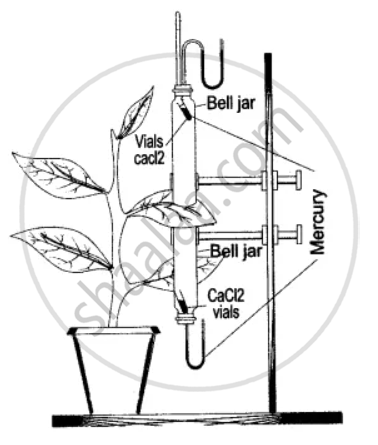Advertisements
Advertisements
Question
Distinguish between the following:
Stomata and lenticels
Solution
| Stomata | Lenticels | ||
| 1. | There are two guard cells in the shape of beans surrounding these small openings. They can be opened and closed. | 1. | There are no guard cells surrounding these special openings. They remain open all the time |
| 2. | They are mostly found on the abaxial surface of leaves. | 2. | These are found on the surface of older woody stems. |
| 3. | These are responsible for the diffusion of gases during photosynthesis and respiration. They also help in transpiration. | 3. | These are mainly responsible for diffusion of gases during respiration. They also help in transpiration. |
APPEARS IN
RELATED QUESTIONS
Name the following:
Any two parts of a leaf which allow transpiration.
Given ahead is a diagram of an experimental setup to study the process of transpiration in plants. Study the same and then answer the question that follows:

- Name the colour of dry cobalt chloride paper.
- Is the experimental leaf a monocot or a dicot? Give a reason to support your answer.
- Why are glass slides placed over the dry cobalt chloride papers?
- After about half an hour, what change, if any, would you expect to find in the cobalt chloride paper placed on the dorsal and ventral sides of the leaf? Give a reason to support your answer.
Differentiate Between Cobalt chloride paper and Goat’s bladder.
The apparatus shown here is Girreau’s poto-meter designed to demonstrate unequal transpiration from the two surfaces of a dorsiventral leaf. Before keeping the leaf in between the cups, anhydrous calcium chloride (CaCl2) contained in two small vials were weighed and placed in both the cups. The ends of the cups were closed with corks through which two mercury manometers were connected. After a few hours, CaCl2 vials were taken out and weighed again.
(i) What is the purpose of keeping CaCl2 vials inside the cup?
(ii) After a few hours, the CaCl2 vials were taken out and weighed again. Will you expect any difference in weight? If so, give reasons.
(iii) What was the purpose of using a mano-meter?
(iv) What do you mean by transpiration?
Draw a neat diagram of the stomatal apparatus found in the epidermis of leaves and label the Stoma, Guard cells, Chloroplast, Epidermal Cells, cell wall and Nucleus.
Give Technical Term
Which side of the leaf has more stomata?
Mark the most appropriate answer in the following:
Stomata open during day and close at night because:
Choose the Odd One Out
Name the following:
The openings on the barks of trees through which transpiration occurs.
